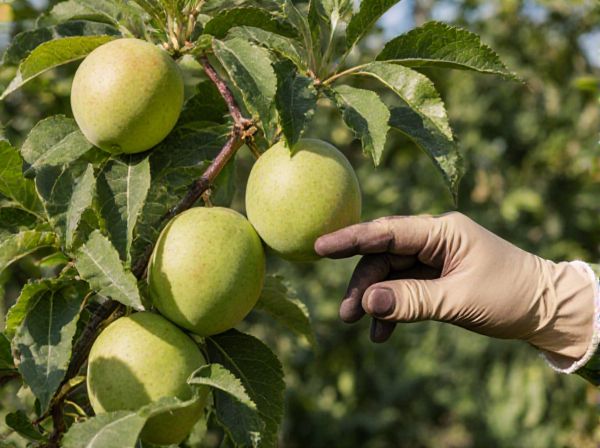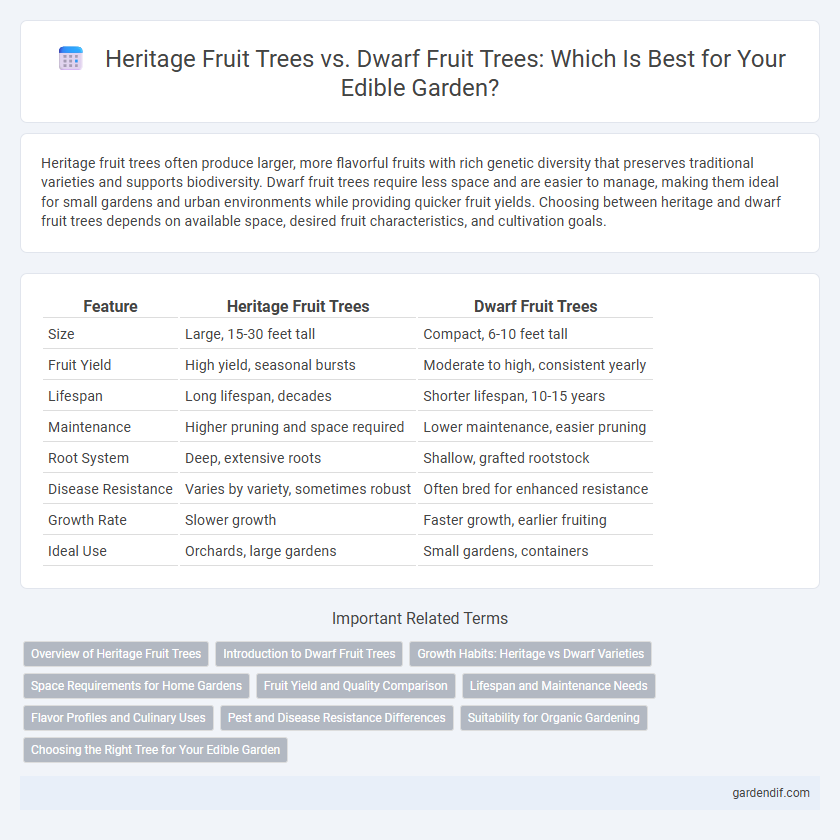
Heritage fruit trees vs Dwarf fruit trees Illustration
Heritage fruit trees often produce larger, more flavorful fruits with rich genetic diversity that preserves traditional varieties and supports biodiversity. Dwarf fruit trees require less space and are easier to manage, making them ideal for small gardens and urban environments while providing quicker fruit yields. Choosing between heritage and dwarf fruit trees depends on available space, desired fruit characteristics, and cultivation goals.
Table of Comparison
| Feature | Heritage Fruit Trees | Dwarf Fruit Trees |
|---|---|---|
| Size | Large, 15-30 feet tall | Compact, 6-10 feet tall |
| Fruit Yield | High yield, seasonal bursts | Moderate to high, consistent yearly |
| Lifespan | Long lifespan, decades | Shorter lifespan, 10-15 years |
| Maintenance | Higher pruning and space required | Lower maintenance, easier pruning |
| Root System | Deep, extensive roots | Shallow, grafted rootstock |
| Disease Resistance | Varies by variety, sometimes robust | Often bred for enhanced resistance |
| Growth Rate | Slower growth | Faster growth, earlier fruiting |
| Ideal Use | Orchards, large gardens | Small gardens, containers |
Overview of Heritage Fruit Trees
Heritage fruit trees are traditional varieties cultivated over centuries, prized for their rich flavors, genetic diversity, and adaptability to local climates. These trees often grow larger and take longer to mature compared to dwarf fruit trees, producing abundant and robust fruit. Preserving heritage fruit trees supports biodiversity and offers a tangible link to agricultural history and sustainable practices.
Introduction to Dwarf Fruit Trees
Dwarf fruit trees are cultivated to remain compact, typically growing between 4 to 8 feet tall, making them ideal for small gardens and container planting. These trees produce full-sized fruit like their heritage counterparts but offer easier maintenance, faster fruiting, and higher density planting options. Their genetic modifications or rootstock selections result in controlled growth, which optimizes space without sacrificing fruit quality or yield.
Growth Habits: Heritage vs Dwarf Varieties
Heritage fruit trees exhibit vigorous growth with extensive root systems and larger canopies, often requiring more space and longer time to mature compared to dwarf varieties. Dwarf fruit trees are genetically bred or grafted to maintain compact size and controlled growth habits, making them ideal for small gardens or container planting. Their reduced vigor allows for easier pruning, harvesting, and higher density planting without compromising fruit yield.
Space Requirements for Home Gardens
Heritage fruit trees typically require more space in home gardens due to their larger root systems and taller growth, often needing 15 to 25 feet of spacing between trees. Dwarf fruit trees are ideal for limited spaces, requiring only 6 to 10 feet apart and reaching heights of 6 to 10 feet, making them perfect for small gardens and container planting. Selecting dwarf varieties maximizes fruit yield per square foot, enhancing productivity in urban or compact garden settings.
Fruit Yield and Quality Comparison
Heritage fruit trees typically produce larger, more complex-flavored fruits with higher sugar content, reflecting traditional cultivars adapted over centuries. Dwarf fruit trees offer earlier fruiting and more manageable yield sizes, often ensuring consistent quality due to controlled growth. While heritage trees may yield less frequently, their fruit quality is prized for artisanal uses, whereas dwarf trees provide reliable harvests suited for small-scale or urban orchards.
Lifespan and Maintenance Needs
Heritage fruit trees typically have a lifespan of 50 to 100 years, offering robust fruit production with moderate maintenance such as pruning and pest control. Dwarf fruit trees, by comparison, live around 15 to 30 years and demand more frequent care, including regular pruning and fertilization to maintain their smaller size and fruit quality. Both types require tailored upkeep, but heritage varieties often need less intensive management over their longer lifespan.
Flavor Profiles and Culinary Uses
Heritage fruit trees produce fruits with complex, rich flavors often prized for traditional recipes and artisanal preserves, showcasing unique taste profiles that reflect their historical cultivation. Dwarf fruit trees yield smaller, sometimes sweeter fruits ideal for fresh eating, snacking, and compact culinary applications like garnishes or salads. Flavor intensity from heritage varieties enhances baking and cooking, while dwarf tree fruits offer convenient versatility and quicker harvests tailored for modern kitchens.
Pest and Disease Resistance Differences
Heritage fruit trees typically exhibit greater genetic diversity, providing enhanced natural resistance to pests and diseases compared to dwarf fruit trees, which often have reduced genetic variability due to selective breeding. The robust immunity of heritage varieties can minimize the need for chemical treatments, while dwarf fruit trees, valued for their compact size and productivity, may require more vigilant pest management. Understanding these differences is essential for sustainable orcharding, as pest and disease resilience significantly impacts long-term tree health and fruit yield.
Suitability for Organic Gardening
Heritage fruit trees, prized for their genetic diversity and natural disease resistance, are well-suited for organic gardening because they require fewer chemical interventions compared to conventional varieties. Dwarf fruit trees, while offering space-saving benefits and easier harvests, may demand more intensive organic pest and nutrient management to thrive in organic systems. Selecting heritage varieties can enhance biodiversity and soil health, key components of sustainable organic gardening practices.
Choosing the Right Tree for Your Edible Garden
Heritage fruit trees offer rich genetic diversity and robust flavors, thriving best with ample space and minimal intervention in your edible garden. Dwarf fruit trees provide high yields in limited spaces, fruiting earlier and allowing easier maintenance, ideal for urban or small-scale gardens. Selecting the right tree depends on garden size, desired harvest volume, and maintenance capacity, ensuring optimal growth and fruit production.
Heritage fruit trees vs Dwarf fruit trees Infographic

 gardendif.com
gardendif.com